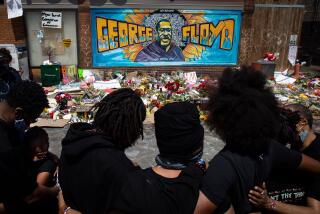TV’s Double-Edged Role in Crisis : Commentary: Airing the King video after the not guilty verdicts could have been a misjudgment that added to the violence.
- Share via
He was irate, he was emotional, he was frightened.
The man on the phone said he was a teacher in “the inner city” and was calling--less than an hour after Wednesday’s acquittal of four Los Angeles police officers in the Rodney G. King case--to protest the “irresponsibility” of KCBS-TV Channel 2 and KNBC-TV Channel 4 in repeatedly reshowing the famous videotape of a seemingly defenseless King being clobbered by officers.
“I have to go down there and work tomorrow,” the teacher said. “I don’t like the King verdict. It stinks. But they (the TV stations) are endangering a lot of people.”
It’s simplistic to blame television for the rioting and fiery holocaust that erupted in Los Angeles following the King trial. After all, TV didn’t sit on the jury whose verdicts touched off the catastrophic reaction. And, in fact, many TV reporters worked tirelessly and courageously from Wednesday night through Thursday morning, putting themselves in danger while covering the initial barrage against South-Central Los Angeles and other areas of the city.
However, if repeatedly playing the King video during the lengthy trial did indeed desensitize jurors to the violence, as some have suggested, there was also the possibility that telecasting the same tape in the trial’s tense aftermath helped inflame some of the passions that drove the violent rage that began early Wednesday evening and continued Thursday.
“Wow!” KABC-TV Channel 7 reporter John North exclaimed after the verdicts were announced. “Obviously, a videotape does not say it all.”
But that tape, combined with the acquittals, said plenty to thousands upon thousands of other Los Angeles citizens, including those whose destructive response to the Simi Valley trial’s outcome was to go berserk.
Although reshowing the King video did serve as a dramatic contrast to the jurors’ perceptions, doing so at this time was a careless misjudgment, possibly making it even harder to achieve the calm that many TV anchors themselves had been urging repeatedly on the air. This mixed message from the media was underlined Thursday morning when Channel 7 twice aired the beating video while interviewing an anonymous juror by phone, and NBC’s “Today” program--the only network morning show not preempted in Los Angeles on Thursday--showed segments of the video four times within a 45-minute span. And KCAL-TV Channel 9 even showed it in slow motion.
If someone was angry and had a predilection toward violence, seeing the King video again and again in this white-hot period following the trial could have been a button-pusher.
The “to-show-or-not-to-show-the-video” question indicates the minefield that the media, especially television, must walk in reporting such a potentially volatile story comprehensively and responsibly.
Late Wednesday afternoon, Channel 2 reporter Bill Pounders and a camera crew were in the jittery Crenshaw district getting responses from blacks to the King verdicts. One man took the lead, emotionally calling for violence in the streets. And because KCBS was live--joining other stations in playing a dangerous Russian roulette with the airwaves--it found itself giving resonance to this firebrand’s destructive, inflammatory message.
Stations gave prominent coverage Wednesday night to eloquent pleas for nonviolence at the First African Methodist Episcopal Church near downtown. Even as anchors and others were calling for cool, however, that evening’s hostile demonstrations at Parker Center and other downtown locations were being bathed in the hot lights of television crews, raising anew the issue of TV unintentionally--but lethally--egging on the very violence that was being condemned. And in the process, those lights possibly even blinded and turned police into Roman candle targets.
At one point that evening, a police officer could be heard telling Channel 7 reporter Linda Breakstone: “If you want to turn your lights on, turn them on the crowd, not on the officers.” The lights went off--at the urging of Channel 7 anchors Paul Moyer and Ann Martin, who, along with Channel 2’s Michael Tuck and KCOP-TV Channel 13’s Ross Becker, were especially adroit at various points during the first hours of violence.
If experience was evident--especially when covering the downtown violence--so was inexperience. In contrast to Breakstone and Channel 4’s Laurel Erickson, for example, Channel 2 reporter Jodi Baskerville at times sounded like a hyper Valley Girl choking on her own adrenaline. At one point, when she and her crew appeared to get entangled with an advancing wall of police officers, a clash ensued, and Baskerville appeared to completely lose her composure. She began shouting. “What’s the problem here? I said, what’s the problem here? They’re not giving me an answer!” Tuck and his co-anchor, Bree Walker, tried to calm her down.
Along with uneven reporting and incredible footage--especially those horrifying chopper pictures of motorists being dragged from their vehicles and savagely beaten with no police in sight--the coverage was marked by irony.
There was Moyer on Wednesday night, apologizing to viewers for calling looters “creeps” and for live coverage of a man with a poster bearing a four-letter synonym for excrement. And on Thursday, there was KABC reporter Art Rascon telling an angry interviewee who had spit out a string of expletives: “You’re going to have to control your language if you’re going to be on television.”
Arson, looting, beating and murdering they show you live. But cursing is where they draw the line.
More to Read
The complete guide to home viewing
Get Screen Gab for everything about the TV shows and streaming movies everyone’s talking about.
You may occasionally receive promotional content from the Los Angeles Times.






